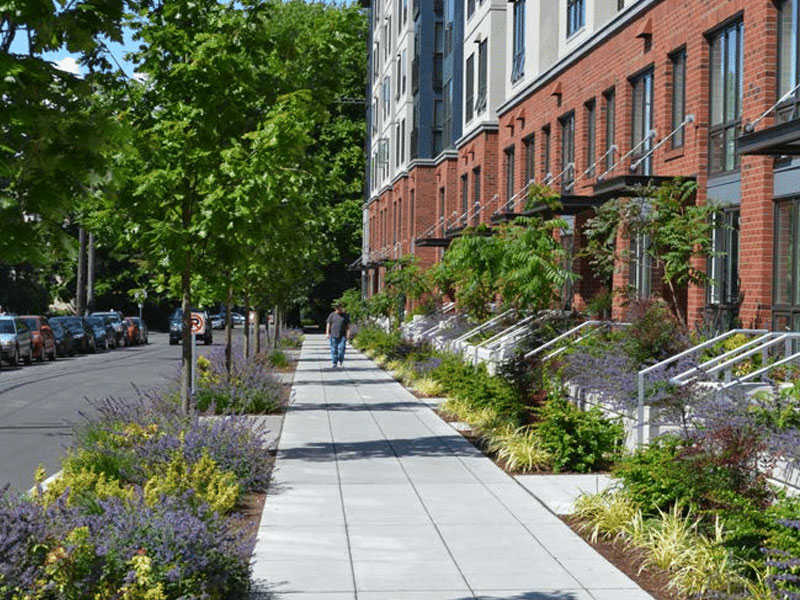Instead of “green space” we must build ecosystems in our cities
~ Mathieu Perchat, from Le Mouton Noir ~
Vegetation in the city, often reduced to the term “green space”, evokes a more complex reality than that of a simple place of rest or walk. The term itself, “green space”, expresses the limitation of this concept: it does not designate a place in its own right, but a portion of territory planned according to criteria of utility rather than aesthetic or ecological ones.
Green space, often reduced to a simple “green”, excludes art, or at least reduces it to a simple decorative packaging. By losing its name and its essence, the urban garden is emptied of any value other than that of hygiene.
In this approach, lawns, gardens and planted paths, as well as street furniture, participate in the form of the city, but under a logic of health control, a hygienist policy. Air, water and vegetation are treated as abstractions, disregarding climatic and geographical diversity. For example, urban gardens become a tool for combating pests, such as rats. As a result, these spaces have no real connection with the larger ecosystem. Ecological criteria are neglected in favour of ornamental objectives; thus, the dryness of the soil and the effects of shade are neglected, accentuating the artificiality of plant choices.
The most striking example is that of trees. They are mainly planted in cities for their aesthetic role, often reduced to a beautification function. For some decision-makers, this aestheticism is summed up in making public spaces more pleasant while contributing to the sanitation of municipalities. Beauty and hygiene are intertwined in this approach, where plants become a simple tool for fighting pests, such as rats.
Towards urban vegetation?
It is urgent to rethink the role of vegetation in the city. Instead of being reduced to a utilitarian function, can it become an aesthetic and symbolic link between urbanized spaces and other ecosystems? The city of tomorrow should be a welcoming space for a plurality of living beings: humans, animals and plants. This need is all the more evident in the face of the impact of urban sprawl, which degrades nearby and distant ecosystems.
Plants, in their landscaping potential, affect various scales: from individual balconies to entire cities. The articulation of these scales, both politically and ecologically, represents a fundamental challenge for rethinking urban planning. Plants are not simply a component of the landscape; they embody strong symbolic values, associated with the diversity of species, and offer unprecedented plasticity to urban planners and planning professionals.
For residents, vegetation represents a local nature, essential to their well-being. It is a crucial resource for biodiversity, particularly in densely populated areas. The implementation of vegetation by municipalities and landlords is therefore part of a broader thinking about urban public space. But spontaneous vegetation, often perceived as uncontrolled, also contributes to shaping public space, by highlighting contrasts with planned vegetation.
A sensory and ecological challenge
The perception of urban vegetation is not limited to a simple visual appreciation. Odorus, colours, flavours and textures play a crucial role in our relationship with the environment. These aesthetic dimensions influence our behaviour towards the city and nature. Unfortunately, institutions in charge of urban ecology struggle to integrate this sensory and participatory biodiversity that residents create through their own practices.
It is therefore essential to encourage policies that promote wildlife in the city. Vegetation should not be thought of solely through the prism of planning, but as a real vector of ecosystems and diversity.
Residents, city dwellers and citizens: a plural relationship to urban space
In this context, it is interesting to examine the different relationships that individuals have with urban green environments. Three main categories of populations emerge:
- Residents, strongly attached to their housing, consider their home as a protective shelter, a place of sensations and materiality. They are particularly sensitive to living conditions in the city and directly perceive the benefits or inconveniences of urban vegetation. Their relationship to space is sensory, marked by a desire for comfort and harmony with their environment.
- City dwellers mainly use the city through a utilitarian practice, often centred on the car and travel. Their perception of places is determined by their use: ease of travel, access to services and parking. This group of people largely rejects an aesthetic approach to the city, preferring immediate functionality.
- Citizens are involved in the collective life of their neighbourhood. They favour public transportation and the efficiency of the metro, willingly mingling with the urban crowd. Their attachment to places is indirect, often mediated by human and social relationships. However, this group tends to forget that the city is also a biological and physical space, where biodiversity plays a key role.
Conclusion: towards a reconciliation with urban nature
Urban morphology constantly interferes with our desire to live. A few green islands, terraces or planted courtyards, break with a predominantly concrete urban landscape. However, these spaces remind us of the importance of nature in urban daily life.
It is imperative to rethink our relationship with vegetation in the city, no longer as a simple tool for development or beautification, but as an essential component of our well-being, our sensitivity and our relationship with the world. The dialogue between ecology, aesthetics and politics must be intensified to create cities where nature finds its rightful place.








